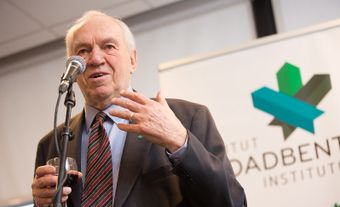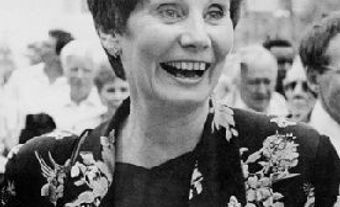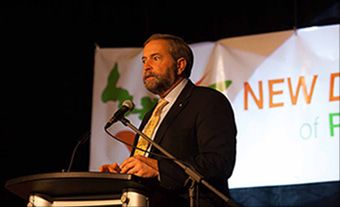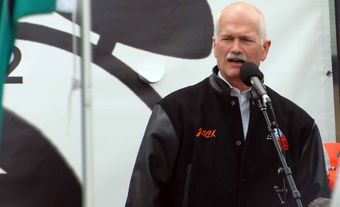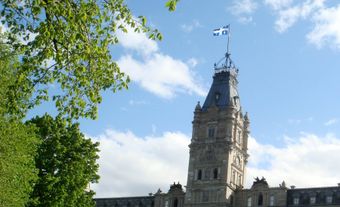Jagmeet Singh “Jimmy” Dhaliwal, leader of the New Democratic Party of Canada 2017–present, MP, MPP, lawyer (born 2 January 1979 in Scarborough, ON). Jagmeet Singh served as an Ontario MPP from 2011 until 2017, when he won the leadership of the federal New Democratic Party (NDP). This made him the first racialized leader of a major national political party in Canada. He was also the first turban-wearing Sikh elected to the Ontario legislature. Singh has consistently rated higher than other federal party leaders in public opinion polls but has yet to translate that into national electoral success. He has been the Member of Parliament for Burnaby South since 2019.
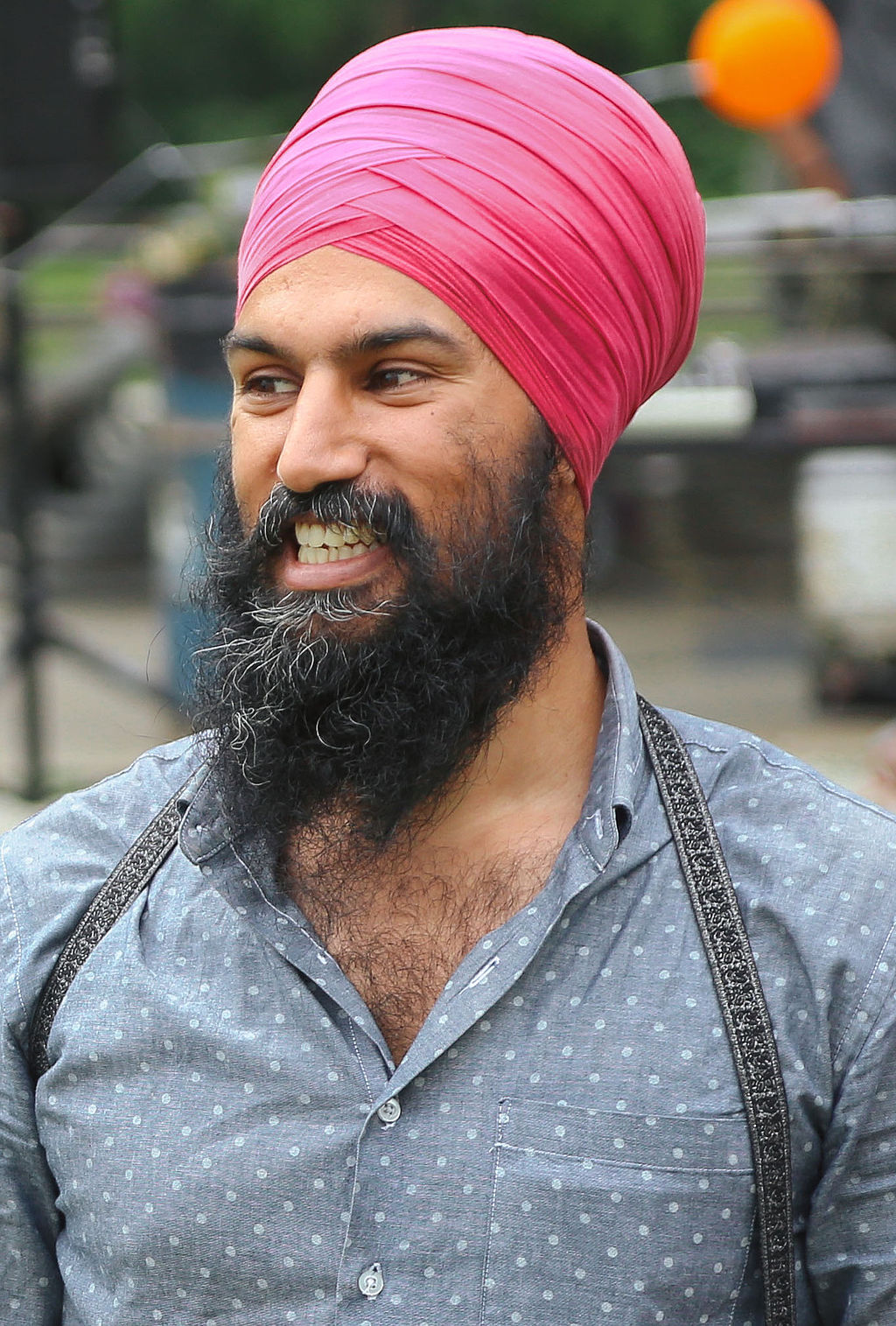
Early Life and Education
Jagmeet Singh was born on 2 January 1979 in Scarborough, Ontario. He was the eldest of three children born to his mother, Harmeet Kaur, and his father, Jagtaran Singh, a psychiatrist. When he was one year old, Singh was sent to his family’s native Punjab, India, to live with his grandparents. At the time, his mother and father were struggling to make ends meet and look after the baby. Harmeet was working in a bank, while Jagtaran was working as a security guard and studying for his medical recertification (he had trained as a physician in India but had to qualify to practise in Canada). However, it wasn’t long before Singh was reunited with his parents and moved with them to St. John’s, Newfoundland, so that his father could attend Memorial University. His sister, Manjot, and brother, Gurratan, were born in Newfoundland. Singh learned English in Newfoundland, where he was known as “Jimmy.”
When Singh was seven, his family moved to Windsor, Ontario, where he grew up. There, he used his given name, Jagmeet. Concerned about bullying, his father sent him to the private Detroit Country Day School in the United States, across the river from Windsor, where he excelled in academics and athletics. As is the egalitarian Sikh custom — to diminish the influence of the caste system of social class distinction — he uses the last name Singh rather than Dhaliwal.
After completing high school, he attended Western University, where he earned a Bachelor of Science in biology before going to Osgoode Hall Law School in Toronto.
Early Career
While Jagmeet Singh spent most of his youth in the New Democratic Party (NDP) hotbed of Windsor, he said he did not become interested in partisan politics until he worked as a criminal defence lawyer in Brampton, ON. “I haven’t been a long-time party activist, I’ve been a long-time sympathizer, you could say. Criminal defence is a bit more liberal, more left wing because of the…social justice aspect of it. We’re advocates of the Canadian Charter [of Rights and Freedoms],” he told the Toronto Star.
Singh did volunteer legal work for social justice groups fighting poverty, helped immigrants and refugees with rights claims, and visited university campuses to give free legal seminars to students.

2011 Federal Election
Moved by the injustices he saw, Jagmeet Singh decided to enter electoral politics. He ran for the federal NDP in the May 2011 federal election in the riding of Bramalea-Gore-Malton. While the party’s then-leader Jack Layton guided the New Democrats to their best ever showing — finishing second to Prime Minister Stephen Harper’s Conservatives — Singh did not ride the NDP’s “orange wave” to victory. Losing by just 539 votes, he was a close runner-up to Conservative Bal Gosal. However, Singh finished ahead of long-time Liberal incumbent Gurbax Malhi, himself a pioneer in 1993 as the first turbaned member of Parliament elected outside India.
While Singh was bitterly disappointed at his loss, his strong showing excited New Democrats. “After that first one I wanted to take a break. Losing is tough, especially when it’s so close. It was really the party that gave me a lot of encouragement — and the community. I got maybe 200 to 300 phone calls of people saying, ‘Don’t give up.’”
Provincial Politics
Jagmeet Singh was convinced to run for Ontario NDP Leader Andrea Horwath’s party in the same riding (Bramalea-Gore-Malton) in the October 2011 provincial election. Attracting youthful volunteers, who treated his campaign office as an after-school community centre, and using social media effectively, Singh won the riding with 38.16 per cent of the vote compared with 32.93 per cent for Liberal incumbent Kuldip Kular. He was the first NDP member of Ontario’s Provincial Parliament (MPP) ever elected in Peel Region.
At the legislature at Queen’s Park, the affable and charismatic newcomer made a stylish entrance. With his red BMW Z4 M coupe, Brompton folding bike, bespoke suits, and colourful turbans, he quickly became one of the most recognizable MPPs. With tens of thousands of Twitter and Instagram followers, he emerged as a rare Canadian celebrity politician, frequently photographed at swish receptions for the society pages.
The Toronto Star anointed Singh as one of its 12 people to watch in 2012, extolling his skills at Brazilian jiu-jitsu and noting he was the first turban-wearing Sikh to sit in the Ontario legislature.
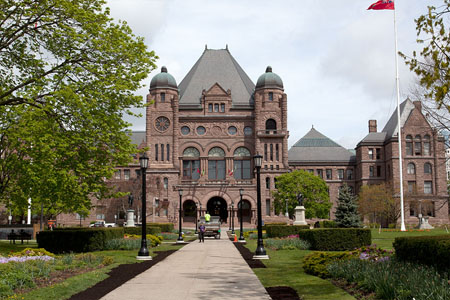
First Term, MPP
At Queen’s Park, Jagmeet Singh championed auto insurance reform and introduced a motion in 2013 to force Premier Kathleen Wynne’s fledgling minority Liberal government to gradually reduce private passenger premiums by 15 per cent. Cutting rates was a key demand of Horwath’s New Democrats in exchange for propping up Wynne’s administration.
In December 2013, Singh was refused a visa to enter India, over comments he had made on that country’s record on human rights. He had been trying to fly to Amritsar, India, to receive the SEWA Sikh of the Year award. Instead, he had to accept the honour in a video presentation and dedicated it to Indian human rights activist Bhai Gurbakhsh Singh Khalsa. Singh said the Indian consulate in Toronto told him he was refused a visa because he was an “outspoken critic” of India’s treatment of minorities, including Sikhs, Muslims, and Christians.
On 2 May 2014, Horwath announced that the New Democrats, along with Tim Hudak’s Progressive Conservatives (PC), would not support the Liberal government budget, plunging Ontario into an election campaign. While the NDP had triggered the snap vote, the party’s lacklustre campaign was disorganized and plagued by internal sniping. Ever the team player, Singh was one of the only MPPs to attend the launch of the party’s campaign manifesto at the University of Toronto.

Second Term, MPP
In the 12 June 2014 election, Singh retained his seat but the NDP lost ground, becoming the third party in the legislature dominated by a majority Liberal government. Still, Singh’s profile remained high.
He was an outspoken advocate of ending the police practice of random spot checks — known as “carding” — that unfairly target visible minorities. He spoke movingly about experiencing the humiliation of being carded in both Toronto and Windsor, telling the Toronto Star, “it made me feel intimidated. It made me feel unsafe … like I just didn’t belong.”
When Wynne’s government decided it would not grant turban-wearing Sikhs an exemption to Ontario’s motorcycle helmet law, Singh noted there was support in the Liberal, PC, and NDP caucuses for a legal exemption — something already in place in Britain, and in British Columbia and Manitoba.
On 20 April 2015, Horwath announced Singh would be the NDP’s deputy leader. Her surprise move came after Singh had turned down weeks of overtures from national NDP leader Thomas Mulcair to run as a candidate in that year’s federal election. “I would never have thought that a little kid from Windsor would end up being a deputy leader of a provincial party one day, so it’s a great honour,” he said.
In 2016, Singh and four other provincial New Democrats opposed a joint Liberal and PC motion to formally denounce the BDS movement — boycott, divest, sanctions — that targets Israel. Singh warned the motion was contrary to “the right to dissent,” but it passed easily in the legislature.
NDP Leadership Campaign
After the federal NDP’s disappointing result in the 2015 election, the party ousted leader Thomas Mulcair at a convention in 2016, clearing the way for a leadership contest. Singh remained coy about whether he might seek the leadership, enjoying instead his celebrity as an Ontario MPP. In February 2017, he was featured in the American men’s style magazine GQ — in an article headlined “A Chat with Jagmeet Singh, the Incredibly Well-Dressed Rising Star in Canadian Politics” — where he said he was “honoured” to be considered a potential federal leader.
Finally, on 15 May 2017, Singh launched his campaign at a Brampton banquet hall beneath a slogan reading “With Love & Courage.” His platform included a plan to decriminalize all illegal drugs — treating addiction as a public health crisis rather than a law enforcement issue — and to ban racial profiling by federal entities like the RCMP. It also included a pledge to reform Canada’s electoral system.
In the all-candidates’ debates, Singh, the only candidate on the stage from the provincial arena, was repeatedly asked if he would run for a federal seat even if he lost the leadership. “I will be winning, and once I win, I will run federally,” he said at a debate in Vancouver. That drew a response from candidate and Manitoba MP Niki Ashton that underscored how much the NDP establishment viewed Singh as an interloper. “I want to acknowledge that it’s up to the members to decide who is going to win this race,” said Ashton.
The most sensational moment of an otherwise sleepy NDP leadership contest came at a campaign rally in Brampton on 6 September 2017. As he stood at the front of the room, Singh was accosted by a heckler named Jennifer Bush, a supporter of an anti-Islamic fringe group. As cameras rolled, an agitated Bush chided Singh for being “in bed with the Muslim brotherhood.” Singh remained calm. Displaying grace under pressure, he encouraged his supporters in a chant of “love and courage” to drown out the hysterical protester. Video of the encounter was viewed more than 35 million times online after it went viral on Twitter and Facebook. He also won praise for not responding to Bush’s claim he was a Muslim. “I didn’t answer the question because my response to Islamophobia has never been: ‘I’m not Muslim.’ It has always been, and will be, that hate is wrong. Once allowed to grow, hate doesn’t pick and choose,” he said.
The encounter electrified New Democrats. Even though it was known that Singh had already sold more party memberships than his rivals, his position as the front-runner was solidified.
NDP members began voting by mail and online on 18 September, with the results of the first ballot announced on 1 October. Singh won a first-ballot victory with 53.8 per cent of the vote. His closest rival, Ontario MP Charlie Angus, received 19.4 per cent. Three weeks after winning the federal leadership, Singh resigned his Bramalea-Gore-Malton seat in the Ontario legislature. He was greeted with a standing ovation by MPPs from all three parties when he made a farewell appearance at Queen’s Park.
Federal NDP Leader
With no seat in the House of Commons, Singh named another leadership candidate, Québec MP Guy Caron, as the party’s leader in Parliament — an appointment seen as a concession to Québecers, who had been instrumental in Jack Layton’s success in 2011 yet were leery of the new leader. Singh said he was “confident … we will be able to grow in Québec” in the 2019 election. However, he also took a strong stance against that province’s controversial Bill 62, which would ban Muslim women from giving or receiving public services while wearing a face covering.
Singh made headlines early in his tenure during an interview with CBC Television. Asked if he condemned Sikhs who revere and display posters of Talwinder Singh Parmar — the reputed mastermind of the 1985 Air India bombing that killed 329 people — Singh called the bombing a “heinous massacre.” However, he pointedly did not denounce those Sikhs who still pay homage to Parmar. (Parmar was tortured and killed by Indian police in 1992.) “I don’t know who’s responsible [for the Air India tragedy] but I think we need to find out who’s responsible, we need to make sure that the investigation results in a conviction of someone who is actually responsible,” the NDP leader said.
One of the most serious challenges facing Singh and the federal NDP was the proposed expansion of the Trans Mountain Pipeline. Rachel Notley, the NDP premier of Alberta, supported the project. However, John Horgan, the NDP premier of British Columbia, opposed the pipeline. Horgan’s minority government depended on the support of the BC Green Party and was fully committed to halting the pipeline expansion. This conflict put Singh and the federal NDP in a difficult position. For months, Singh tried to remain neutral, calling for a more thorough environmental assessment of the project. However, in May 2018, he announced his opposition, leading Notley to call his position “naive.”
By this point, Singh still did not have a seat in the House of Commons. In August 2018, Singh announced that he would run in the Burnaby South by-election in British Columbia. The Vancouver-area riding had been vacant since June, when NDP MP Kennedy Stewart resigned to run for election as mayor of Vancouver (Stewart won the election and became mayor in October 2018). On 25 February 2019, Singh was elected MP for Burnaby South, winning 39 per cent of the vote and defeating his main rivals in the by-election, Liberal candidate Richard Lee and Conservative candidate Jay Shin.
2019 Federal Election
On 16 June 2019, Singh and the NDP announced A New Deal for People, the party’s campaign platform for the October federal election. One of its key policies was a national pharmacare program. The platform also addressed climate change, vowing to end subsidies to gas and oil companies and increase emissions targets. The party also promised to expand cell coverage and broadband Internet and set caps on Internet and cell phone bills. In addition, the NDP platform emphasized affordable housing and confirmed its commitment to reconciliation and Indigenous rights. It also promised better housing, clean water and education for First Nations, Inuit and Métis communities. To help pay for these plans, the NDP proposed increasing the corporate tax rate and highest income tax rate, as well as imposing a new one per cent wealth tax on fortunes worth over $20 million.
During the 2019 campaign, Singh announced several new policies aimed at shoring up and enhancing support in Quebec, where polls indicated Quebecers were largely abandoning the party. These included a promise for more money for immigrant integration; recognition of the importance of Quebec’s cultural autonomy, and an effective veto over infrastructure projects that have an environmental impact, such as pipelines. Singh also suggested that he could make Quebec — the lone province that has not signed the Canadian Constitution — a signatory, though he did not specify how he would achieve that.
Singh was also criticized — including by some in his own party — for declaring before the election campaign that he would not work with the Conservative government if it won a minority in the election and wanted to look to the party for support for some measures. Critics suggested that he was effectively conceding that the NDP could not win the election itself and said he was also forsaking a potentially valuable bargaining chip in such an event.
At the beginning of the election campaign, Singh and the NDP were virtually tied with Elizabeth May’s Green Party in public opinion polls. However, the New Democrats pulled ahead of the Greens as the election neared, due in large part to Singh’s performance in televised leader debates. He was also praised for his reaction when photos and video surfaced showing Liberal leader Justin Trudeau in blackface on three separate occasions. Rather than dwell on Trudeau’s behaviour or motivations, Singh focused on those who had been hurt by racism:
The kids that see this image, the people that see this image, are going to think of all the times that they were made fun of, that they were hurt, that they were hit, that they were insulted, that they were made to feel less because of who they are … I want you to know that you have value, you have worth and you are loved. And I don’t want you to give up on Canada, and please don’t give up on yourselves.
By the end of the election campaign, Singh and the NDP had reason to be optimistic, despite earlier predictions that it might lose party status. However, the federal election on 21 October 2019 was a disappointment in many ways. While Singh kept his seat in Burnaby South, the NDP was reduced to 24 seats in the House of Commons, dropping to fourth place overall. The party lost all but one of its seats in Quebec, where the Bloc Québécois enjoyed a resurgence. The NDP was also shut out of the Greater Toronto Area, which the Liberals dominated. Despite this, Singh was optimistic about his party’s ability to influence policy in the new Liberal minority government.
Opposition, 2019–21
A skilled debater, Singh remained effective as an opposition leader who often asked stinging questions during Question Period. In June 2020, Singh was leading efforts in the House of Commons to have all parties agree to a motion stating that systemic racism existed in the RCMP and that it should be investigated and addressed. Bloc Québécois MP Alain Therrien was alone in not supporting the motion. At one point while Singh was speaking, Therrien waved his arm as if to dismiss the points being made. Singh called Therrien a racist. When Singh refused the Speaker’s direction to withdraw the insult and apologize, he was removed from the House for the remainder of the day. He then repeated his accusation outside the House. Singh’s actions brought increased national attention to the issue of systemic racism and presented him as one who was standing up for racialized minorities in Canada.
The Liberal minority government needed the support of at least one other party to remain in office. Singh proved adept at negotiating with Prime Minister Trudeau for NDP support. He was especially effective in helping to shape the government’s response to the COVID-19 pandemic — the most critical issue addressed during the parliamentary session.
Beginning in spring 2020, the government undertook various initiatives to help Canadians. The Liberals proposed direct financial aid for students but Singh made it clear the NDP would not support the program without increasing the amount of aid. The government agreed. Singh told the prime minister that he could count on continued NDP support only if he committed to improving paid sick leave. Again, the prime minister agreed. To help Canadians who lost their jobs due to the pandemic, the government offered a Canadian Emergency Relief Benefit (CERB) of $1,000 per month for 16 weeks. Singh said he would only vote for the CERB if it was $2,000 a month and extended to 28 weeks. The prime minister agreed. As a result of Singh’s pressure and promise of support, the government also agreed to increase its original 15 per cent wage subsidy to 75 per cent.
2021 Federal Election
On 15 August 2021, Prime Minister Trudeau called a federal election for 20 September. As in 2019, Singh was an enthusiastic campaigner and again used social media to his advantage. Unlike other party leaders, he regularly posted short clips on TikTok that demonstrated his self-deprecating sense of humour. Singh visited 51 ridings held by Conservative and Liberal MPs with the hope of flipping them to the NDP. An opinion poll released by Abacus Data on 26 August found that Singh was “by far the most popular leader in the country,” with 42 per cent of respondents expressing a positive view and only 24 per cent a negative one.
Unlike in 2019, Singh did not rule out the possibility of working with a Conservative minority government. But he focussed most of his comments on Justin Trudeau. Singh emphasized in nearly every speech and response to reporters that Trudeau spoke well on issues but did not carry through on promises. Singh repeatedly brought attention to such issues as taxing wealthy Canadians, solving the climate crisis, improving access to housing, and ensuring that all Indigenous communities have clean drinking water.
However, the election results were disappointing for Singh and the NDP. The Liberals maintained their minority government status with 159 seats, the Conservatives won 119, and the Bloc Québécois came third with 33 seats. Although the NDP increased its share of the popular vote from 16.0 per cent in 2019 to 17.8 per cent, the party again finished fourth with 25 seats, one more than in 2019. On election night, Singh spoke of continuing to fight for Canadians on the issues he had raised in the campaign.
The party then began a process of examining the campaign. Singh’s practice of taking funds from local ridings to support his own campaign came under scrutiny and drew much criticism. This, combined with Singh’s second underwhelming election result, led some in the party to wonder if it was time for new leadership.
Personal Life
In 2018, Jagmeet Singh married Gurkiran Kaur Sidhu, a fashion designer and an entrepreneur.

 Share on Facebook
Share on Facebook Share on X
Share on X Share by Email
Share by Email Share on Google Classroom
Share on Google Classroom
